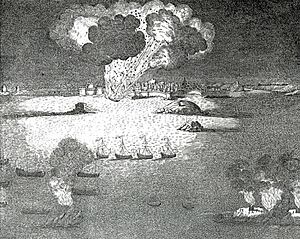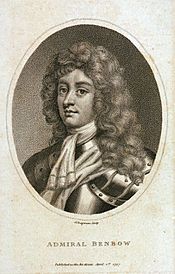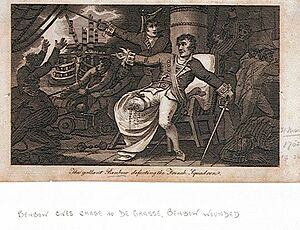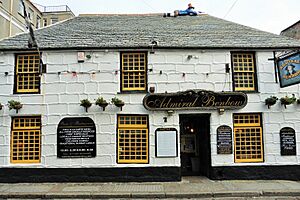John Benbow facts for kids
Quick facts for kids
John Benbow
|
|
|---|---|
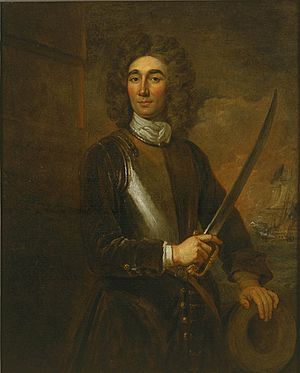
|
|
| Nickname(s) | "Brave Benbow", "A Brother Tar" |
| Born | 10 March 1653 Shrewsbury, England |
| Died | 4 November 1702 (aged 49) Port Royal, Jamaica |
| Allegiance | |
| Service/ |
|
| Years of service | 1678–1702 |
| Rank | Vice-admiral of the White |
| Commands held | HMS York HMS Bonaventure HMS Britannia HMS Sovereign HMS Norwich HMS Northumberland HMS Charles Galley HMS Suffolk HMS Duke HMS Gloucester HMS Breda Jamaica Station |
| Battles/wars | Battle of Beachy Head Battles of Barfleur and La Hogue Action of August 1702 |
Vice-Admiral John Benbow (born March 10, 1653 – died November 4, 1702) was a brave English officer in the Royal Navy. He joined the navy when he was 25 years old. He fought against Algerian pirates. Later, he worked in the merchant navy, trading goods. After the Glorious Revolution in 1688, he returned to the Royal Navy as an officer.
Benbow fought against France during the Nine Years War (1688–1697). He served on and later commanded several English ships. He took part in important battles like Beachy Head in 1690 and Barfleur and La Hogue in 1692. He became famous for fighting against pirates from Salé and the Moors. He also helped attack Saint-Malo and fought the French in the West Indies during the War of the Spanish Succession (1701–1714).
Because of his success, Benbow became a well-known admiral. However, he was involved in a difficult situation in August 1702. Some of his ship captains refused to support him during a battle. Benbow ordered a trial for these captains. Some were put in prison or even executed, but Benbow died before seeing these results. These events made him even more famous and led to many stories and songs about him.
Contents
John Benbow was born on March 10, 1653, in Coton Hill, Shrewsbury, Shropshire. His parents were William and Martha Benbow. Some records say he was born in 1650. His family was not wealthy, which might have led him to a career at sea.
Benbow joined the Royal Navy on April 30, 1678, at age 25. He started as a master's mate on the ship HMS Rupert. He sailed to the Mediterranean Sea, where English ships often fought against Barbary pirates from North Africa. These pirates attacked European trading ships. Benbow showed great courage in battles against these pirate ships. His actions impressed his commanders.
In 1679, Benbow became master aboard HMS Nonsuch. This ship stayed near Tangiers and the African coast. Several future admirals commanded Nonsuch and were all impressed by Benbow's skills. They later helped him advance in his career.
A Dispute and Merchant Trading
In August 1681, Nonsuch fought the Algerine warship Golden Horse. Another English ship, HMS Adventure, had already engaged the pirate ship. After the battle, a disagreement arose about how to share the prize money. Benbow repeated some negative comments made by his crew about Adventure's crew. This led to a court-martial against Benbow. The court found that he had only repeated the words, not started them. He was ordered to give up three months' pay and apologize to Captain Booth of Adventure.
After this, Benbow left the Royal Navy in November 1681. He became a merchant sailor, trading goods between London, Bristol, and ports in Italy and Spain. By 1686, he owned and commanded his own trading ship called Benbow. In May 1687, his ship, Malaga Merchant, was attacked by a pirate from Salé. Benbow bravely defended his ship and fought off the attack. It is said that he cut off the heads of thirteen pirates killed on his ship. He then took them to Cadiz to claim a reward. This story shows how tough and determined he was.
Benbow returned to the Royal Navy after the Glorious Revolution in 1688. On June 1, 1689, he became the third lieutenant of HMS Elizabeth. Soon after, on September 20, he was given his first command as captain of HMS York. He then commanded other ships, including HMS Bonaventure and HMS Britannia.
His next important job was as Master Attendant at Deptford Dockyard in March 1690. This meant he was in charge of fitting out and repairing ships. In the summer of 1690, he served as master of the fleet aboard HMS Sovereign. He took part in the Battle of Beachy Head, where the English fleet was defeated. Benbow was known for his knowledge of navigation and guiding ships. He gave evidence in the investigation after the battle, supporting his former commander.
Benbow continued to serve as master of the fleet in 1691 and 1692. He worked closely with other important naval officers. He helped guide the fleet during the important Battles of Barfleur and La Hogue. After these battles, he returned to his duties at Deptford Dockyard, helping to repair the fleet. He was paid extra for his special services.
Attacking French Ports
In September 1693, Benbow returned to active naval service. He helped lead a group of bomb vessels to attack Saint-Malo in France. These ships could fire powerful bombs. Benbow commanded HMS Norwich and started the attack on November 26. They tried to use a large fireship filled with explosives to damage the town walls. It exploded, causing a lot of damage. Benbow's forces also captured a fort.

Benbow's success led him to command another group of bomb vessels. This time, the target was Dunkirk. He helped prepare special exploding ships for this mission in 1694. The attack was planned for September, but the French blocked the port entrance. A storm also stopped the operation. Benbow then sailed to Calais and bombarded it on September 27. He then went back to his dockyard duties.
Becoming an Admiral
In March 1695, Benbow was back at sea, commanding English ships off the coast of France. His squadron was very successful, capturing many French merchant ships. Because of his good work, he was recommended for promotion to rear-admiral. He was given command of the 70-gun HMS Northumberland. His fourteen-year-old son, also named John Benbow, joined him as a volunteer.
Benbow then sailed with other admirals to Saint-Malo to stop French privateers (pirates working for the French government). Benbow commanded HMS Charles Galley to lead the attack closer to shore. They attacked Saint-Malo on July 4, but the results were not decisive. Benbow then attacked Granville on July 8, firing over 900 bombs and setting the town on fire.
Missions in the West Indies
In March 1698, Benbow was made commander-in-chief of the King's ships in the West Indies. His main job was to stop piracy. He sailed in November, reaching Barbados in February 1699. He then sailed to the Spanish Main on his flagship, the 60-gun HMS Gloucester. He forced the governor of Cartagena to release two English merchant ships. These ships were meant for a Scottish colony, which the English government wanted to fail.
Benbow then sailed north to Newfoundland to chase pirates, but they escaped. He returned to England in the summer of 1700. He was promoted to rear-admiral of the red in April 1701, and then to vice-admiral of the blue in June. He flew his flag on the 70-gun HMS Breda.
The Battle of August 1702
As war became likely, the English government worried about the Spanish silver fleet. They feared France would capture the treasure. Benbow was secretly ordered to find the fleet and bring it to England. He sailed to the West Indies in September 1701, arriving in November. He was joined by other ships in May 1702.
The War of the Spanish Succession had now begun. Benbow learned that a French squadron under Admiral Jean du Casse was in the area. Benbow's ships spotted the French fleet on August 19, 1702. The French had three transport ships and four warships. Benbow had seven ships. The English ships were spread out, and the wind was light, making it hard to form a battle line. A battle began, lasting about two hours, until nightfall.
During this battle, some of Benbow's captains did not follow orders. Captain Richard Kirkby of HMS Defiance did not keep his ship in line. Benbow decided to lead the attack himself. His ship, Breda, pulled ahead, followed by HMS Ruby under Captain George Walton. These two ships kept fighting the French through the night. The other five English ships refused to get close to the enemy.
The chase continued until August 24. Only Benbow, Walton, and Captain Samuel Vincent of HMS Falmouth actively fought the French. At times, they faced fire from the entire French squadron alone. On August 23, Ruby was damaged, and Benbow ordered her to return to port. On August 24, the French ships attacked Breda from behind. Benbow was hit by a chain-shot that broke his leg. He was carried below deck.
Despite his severe injury, Benbow insisted on continuing the fight. Captain Kirkby tried to convince him to stop, but Benbow refused. He called a meeting of his captains. They all signed a paper saying they believed the squadron was too damaged and lacked enough men and ammunition to continue. They recommended breaking off the fight. Benbow suspected his captains were being cowardly or even traitors. He ordered the squadron to return to Jamaica. Once there, he had the captains arrested for a trial.
After the battle, Admiral du Casse sent a letter to Benbow: "Sir, I had little hopes on Monday last but to have supped in your cabin: but it pleased God to order it otherwise. I am thankful for it. As for those cowardly captains who deserted you, hang them up, for by God they deserve it. Yours, Du Casse."
The Trial of the Captains
Acting Rear-Admiral Whetstone returned to Port Royal, and preparations began for the trial of the captains. Captain Thomas Hudson had died before the trial. The remaining captains faced a court-martial on Benbow's ship, Breda, from October 19 to 23. Benbow, though injured, was present.
The court found Captain Kirkby of Defiance and Captain Cooper Wade of Greenwich guilty. They were found guilty of not following orders, neglecting their duty, and signing the paper that made the admiral stop the chase. They were sentenced to be shot.
Captain John Constable of HMS Windsor was found guilty of not following orders and drunkenness. He was removed from the navy. Captain Samuel Vincent of Falmouth and Captain Christopher Fogg of Breda were also sentenced to be removed for signing the paper. However, Benbow himself said they had fought bravely, so their sentences were changed.
The sentences needed approval from Queen Anne. In January 1703, she allowed the sentences to proceed. Constable was imprisoned until 1704, when the Queen pardoned him. Kirkby and Wade were shot aboard HMS Bristol on April 16, 1703, in Plymouth Sound.
Death and Legacy
Benbow died in Port Royal, Kingston, Jamaica, on November 4, 1702. His leg wound from the battle never healed properly. This, combined with his sadness over his captains' actions, led to his death. He was buried on November 16 in St Andrew's Church, Kingston. A marble slab marks his grave. It says he was "a true pattern of English Courage, who lost his life in Defence of his Queene & Country."
Before news of his death reached London, the Queen was very pleased with Benbow's actions. She was also very angry with the officers who had deserted him. The government was planning to promote him again.
"Brave Benbow" in Popular Culture
Benbow's fame grew, and his name became part of popular culture. A monument was built for him in 1843 in St Mary's Church, Shrewsbury. It calls him "a skillful and daring seaman whose heroic exploits long rendered him the boast of the British Navy." Several Royal Navy ships were named HMS Benbow in his honor.
There are many pubs around the world called Admiral Benbow. It's hard to say if they are named after the admiral himself or after the fictional "Admiral Benbow Inn" in Robert Louis Stevenson's famous novel Treasure Island. Some believe Stevenson named his inn after a real pub in Penzance, which was linked to smugglers.
The incident in August 1702, where his captains failed him, became a famous folk song. It is known as "Brave Benbow." The song tells the story of the battle and Benbow's courage despite his injuries.
Come all you seamen bold
and draw near, and draw near,
Come all you seamen bold and draw near.
It's of an Admiral's fame,
O brave Benbow was his name,
How he fought all on the main,
you shall hear, you shall hear.
Brave Benbow he set sail
For to fight, for to fight
Brave Benbow he set sail for to fight.
Brave Benbow he set sail
with a fine and pleasant gale
But his captains they turn'd tail
in a fright, in a fright.
Says Kirby unto Wade:
We will run, we will run
Says Kirby unto Wade, we will run.
For I value no disgrace,
nor the losing of my place,
But the enemy I won't face,
nor his guns, nor his guns.
The Ruby and Benbow
fought the French, fought the French
The Ruby and Benbow fought the French.
They fought them up and down,
till the blood came trickling down,
Till the blood came trickling down
where they lay, where they lay.
Brave Benbow lost his legs
by chain shot, by chain shot
Brave Benbow lost his legs by chain shot.
Brave Benbow lost his legs,
And all on his stumps he begs,
Fight on my English lads,
'Tis our lot, 'Tis our lot.
The surgeon dress'd his wounds,
Cries Benbow, cries Benbow
The surgeon dress'd his wounds, cries Benbow.
Let a cradle now in haste,
on the quarterdeck be placed
That the enemy I may face
'Til I die, 'Til I die.
The composer Ralph Vaughan Williams used the tune of "Brave Benbow" in his musical piece called Sea Songs. This shows how important Benbow's story became in English culture.
See also
 In Spanish: John Benbow para niños
In Spanish: John Benbow para niños



